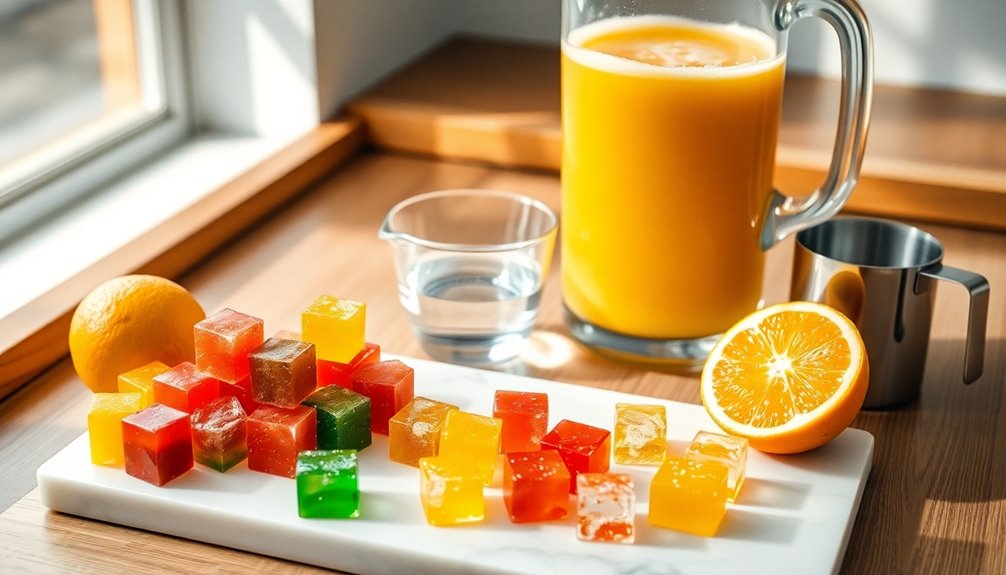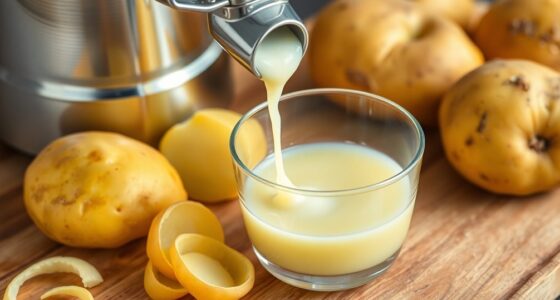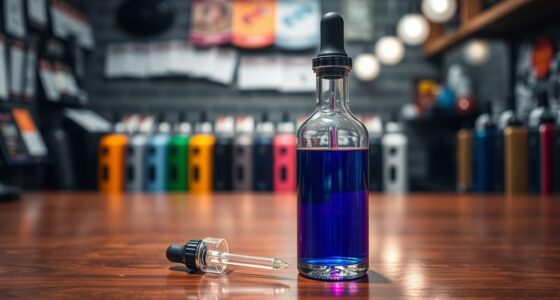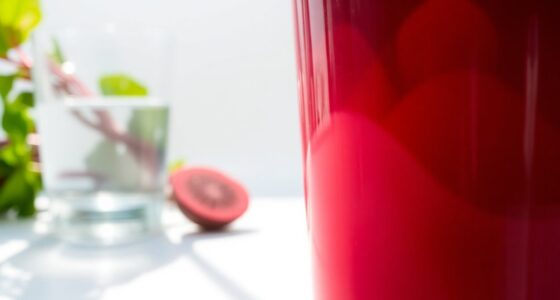To make juice from frozen concentrate, peel and pop the top of the can to reveal the thick contents. Pour it into a clean container and mix with three cups of cold water, adjusting to your taste. Stir thoroughly until it’s smooth and vibrant. Serve it chilled, freeze for a slushy, or enhance with fresh fruit and mint for extra flavor. There are even more creative ways to enjoy your juice that you’ll want to try out! For a delightful twist, consider using your juice to make a homemade juice ice pops recipe. Simply pour the mixed juice into ice pop molds, insert sticks, and freeze for a refreshing treat on hot days. These colorful pops not only quench your thirst but also provide a fun, fruity snack that kids and adults alike will love!
Key Takeaways
- Peel off the flap and pop the top of the frozen juice concentrate can to access the contents.
- Pour the frozen concentrate into a clean juice container and mix with three cups of cold water.
- Stir the mixture thoroughly until smooth and well-mixed, ensuring there are no clumps.
- Serve the juice chilled or freeze it for a slushy treat, stirring every 30 minutes.
- Enhance the juice by adding fresh fruit, mint, or mixing different flavors for variety.
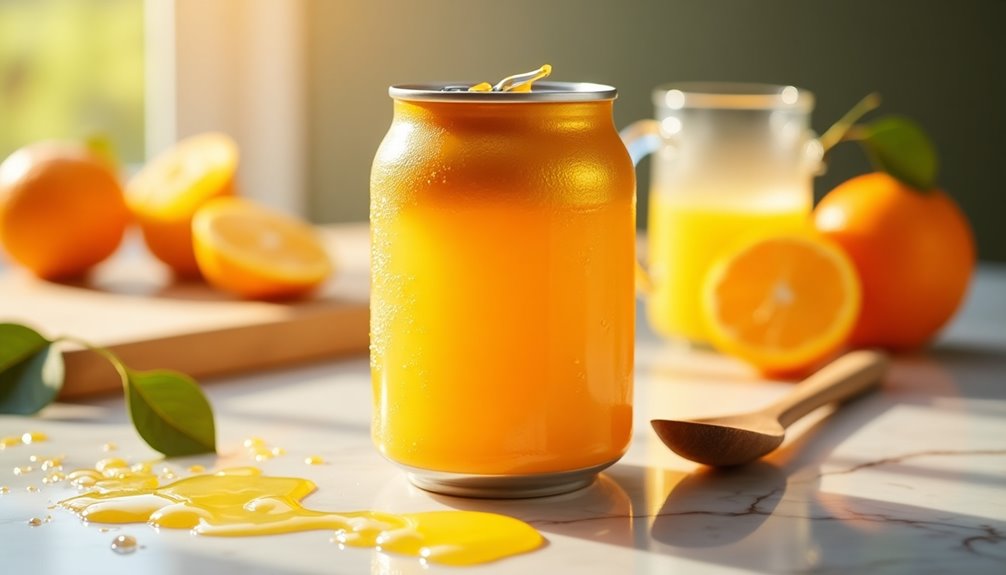
Making juice from frozen concentrate is a quick and easy process that can refresh your day. It's perfect for those moments when you crave a delicious drink without the hassle of starting from scratch. If you've got a can of frozen juice concentrate, you're just a few simple steps away from enjoying a refreshing beverage.
First, you'll need to access the juice concentrate. Take a moment to peel off the flap and pop the top of the can. This'll give you access to the thick, frozen contents inside. Once you've done that, pour the contents of the can into a clean juice container. This is where the magic begins.
Next, you'll need to dilute the concentrate for the best flavor. The can usually recommends mixing it with three cups of cold water, but don't hesitate to adjust that amount based on your personal taste preferences. If you like your juice a bit stronger, you might want to use less water. Conversely, if you prefer a lighter flavor, add a bit more. It's all about what you enjoy.
After you've added your water, grab a spoon and stir the mixture thoroughly. This is one of the key steps in the process. You want to ensure that the concentrate and water blend together into a uniform consistency, without any clumps. Keep stirring until it feels smooth and well-mixed. The vibrant color of the juice should be a good indicator that you've achieved the right consistency.
Once your juice is mixed, you've got a couple of options. You can either serve it chilled immediately or take it a step further by freezing it. If you're in the mood for a slushy treat, pour your juice into a freezer-safe container and place it in the freezer. After a couple of hours, check on it. You'll want to stir it every 30 minutes or so to break up any ice crystals that form, creating that perfect slushy texture.
When you're ready to serve, whether it's straight from the container or as a slushy, you'll have a delicious drink that's sure to satisfy. If you're feeling creative, consider adding fresh fruit or a sprig of mint for a little flair. You can even mix different flavors of juice concentrate for a unique twist. Drinking cold-pressed vegetable juice can also be a great way to enhance your nutrient intake alongside your frozen juice.
In just a few simple steps, you can transform a can of frozen concentrate into a delightful juice that can bring a burst of freshness to your day. So next time you find a can of frozen juice concentrate in your freezer, don't hesitate to whip up a quick and tasty drink. It's a fun, easy way to enjoy a refreshing beverage that'll keep you coming back for more.
Frequently Asked Questions
How to Make Juice From Frozen Juice Concentrate?
To make juice from frozen juice concentrate, start by opening the can and pouring the concentrate into a juice container.
Fill the empty can with cold water—about three cups—then add it to the container with the concentrate.
Stir the mixture well to dissolve any clumps. If you want a sweeter or stronger flavor, adjust the water to your taste.
For a cool treat, freeze the juice until it's the consistency you like, then enjoy!
Do You Add Water to Juice From Concentrate?
Yes, you definitely add water to juice from concentrate.
It's essential for diluting the concentrate to get the right flavor and consistency. Typically, you'll mix one can of concentrate with three cans of cold water, but you can adjust that based on your taste.
If you prefer a stronger flavor, use less water; for a milder taste, add more. Just make sure to mix it well to avoid clumps!
How Do You Thaw Frozen Juice Concentrate?
To thaw frozen juice concentrate, you've got a couple of options.
You can simply place the can in the refrigerator for several hours or overnight.
If you're in a hurry, run the can under warm water for a few minutes, but steer clear of boiling water.
Alternatively, you can microwave the concentrate in a safe container, stirring it in short intervals.
Always check for any off smells or discoloration before using it!
How Much Water to Add to Frozen Orange Juice Concentrate?
When you're preparing frozen orange juice concentrate, you'll want to add three cups of cold water for each can of concentrate.
Using the empty can for measuring helps ensure accuracy. If you prefer a stronger flavor, feel free to adjust the water to your taste.
Just make sure to mix it well with a spoon to eliminate any clumps. Following the specific instructions on your concentrate can is also a good idea for best results.
Conclusion
Now that you know how to transform frozen concentrate into a refreshing drink, you're ready to quench your thirst like a bard crafting a sonnet. With just a few simple steps, you can create a beverage that rivals summer's best offerings. So, pour yourself a glass and savor the taste of homemade goodness; it's a small yet delightful pleasure that elevates the everyday, reminiscent of the ambrosia enjoyed by the gods of Olympus. Cheers!
Cindy thoroughly researches juicing trends, techniques, and recipes to provide readers with practical advice and inspiration. Her writing style is accessible, engaging, and designed to make complex concepts easy to understand. Cindy’s dedication to promoting the advantages of juicing shines through her work, empowering readers to make positive changes in their lives through the simple act of juicing.

